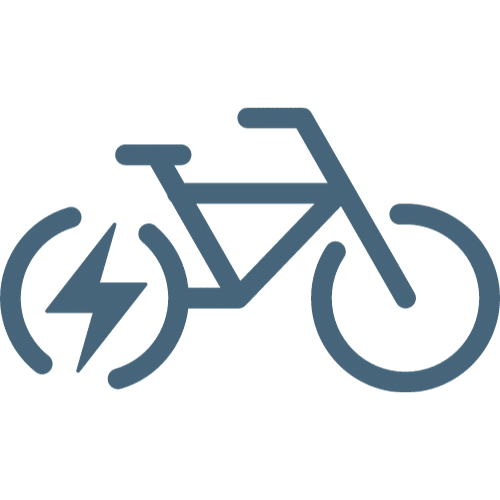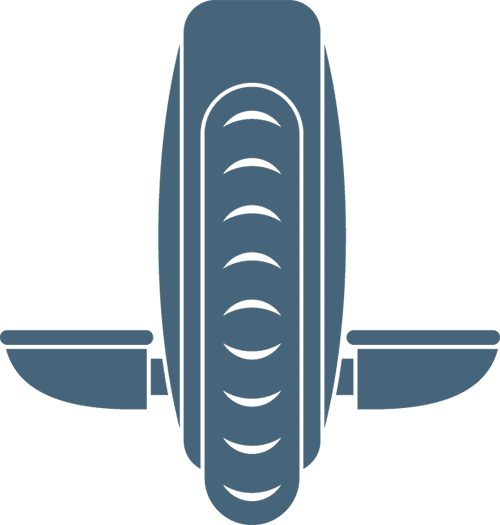There are 4 main PEV-types that we focus on: E-Bikes, E-Scooters, EUCs and Onewheels. Battery size is the #1 factor that can maximize PEV range. Based on our 4 databases containing data on nearly every E-Bike, E-Scooter, EUC and Onewheel, here is the average battery size breakdown for each type:
Largest Battery by PEV type
- E-Bike – ONYX RCR (2952 Wh)
- E-Scooter – FLJ K13 (5760 Wh)
- EUC – Begode Master Pro (4800 Wh)
- Onewheel – Floatwheel adv Pro (621 Wh)
Median Battery Size by PEV type
- E-Bike – 672 Wh
- E-Scooter – 930 Wh
- EUC – 1750 Wh
- Onewheel – 375 Wh
It’s clear from this data that Onewheels have the smallest batteries (and therefore smallest range) on average, followed by E-Bikes, with E-Scooters and EUCs taking the top two spots. Since it can be reasonably estimated that cruising at 20mph on any PEV uses about 30 Wh of energy per mile, the median data on PEV battery size predicts the following:
Median Range (at 20 mph) by PEV type
- E-Scooter – 31 miles
- EUC – 58 miles
- Onewheel – 12.5 miles
The reason I left E-Bikes off the list is because most people use a combination of pedal power and electric assist when riding an E-Bike. Using exclusively electric power (assuming the bike has a throttle) you can anticipate 22.5 miles on the average E-Bike.
Maximize PEV Range
There are numerous additional factors besides battery size that influence range, listed in rough order of importance:
- Riding speed
- Elevation gain/loss
- Ambient temperature
- Wind conditions
- Rider weight
- Riding stance
- Frequency of starts/stops
- Terrain
- Aggressive vs light acceleration
- Tire pressure
- Tire tread
- Lights
Riding Speed – To maximize PEV range, ride slower
Speed, after battery size, is the single biggest indicator of how far you can expect to ride on a PEV. Here is a rough table I have created to assist in estimating range based on speed:
Speed | Power Consumption |
15 mph | 25.0 Wh/mile |
20 mph | 29.4 Wh/mile |
25 mph | 34.3 Wh/mile |
30 mph | 40.8 Wh/mile |
35 mph | 49.1 Wh/mile |
40 mph | 59.6 Wh/mile |
45 mph | 72.4 Wh/mile |
50 mph | 87.4 Wh/mile |
55 mph | 104.8 Wh/mile |
60 mph | 124.5 Wh/mile |
To calculate range, simply divide the PEV’s battery capacity (in Wh) by the given power consumption. For example, if I am riding a Onewheel GT S-Series (which has a 437 Wh battery) at 15 mph, I could expect a range of roughly 17.5 miles.
Elevation Gain/Loss – To maximize PEV range, avoid hills
Riding up hills depletes a PEV battery significantly quicker than riding on level ground, because in addition to pushing the rider forward through the air, the battery now has to lift the rider up. Here is a rough way to calculate the effects of elevation gain on battery life using the formula for gravitational potential energy:
E = mgh
Where E is the energy required, m is the mass of the object, g is the acceleration due to gravity, and h is the height the object is lifted.
Consider riding a Onewheel GT S-Series up a 15% grade hill for 1/2 mile. Using this handy online tool, we can see that our total elevation gain will be 396 ft. The weight of a Onewheel GT S-Series is 33 lbs, so adding a 150 lb rider gives us a total weight of 183 lbs. To calculate the energy required to lift a 183 lb object to a height of 396 ft, we need to convert the mass from pounds to kilograms:
m = 183 lbs × 0.453592 kg/lb ≈ 83.007 kg
And convert the height from feet to meters:
h = 396ft × 0.3048m/ft ≈ 120.701m
Now, using the standard acceleration due to gravity (9.8m/s^2) we can use the formula:
E = (83.007kg) × (9.8m/s2) × (120.701m) = 99,514.93 J
So, approximately 99,514.93 joules of energy would be required to lift a 183 lb object to a height of 396 ft.
3600 joules is equal to 1 Watt-hour (Wh), so 99,514.93 joules is equal to 27.64 Wh. Obviously due to friction losses and motor inefficiencies, the total amount of Wh would be substantially more than this, but 28 Wh is a good low-end estimate.
Ambient Temperature – To maximize PEV range, avoid extreme temperatures (especially cold)
It has been widely documented that driving Electric Vehicles in the cold depletes the battery capacity much quicker than driving in warmer temperatures. According to this article, 70 degrees Farenheight seems to be the sweet spot, with most EVs performing about 15% better than expected at this specific temperature. Dropping into freezing temperatures can reduce range estimates by as much as 50%, as I have personally experienced from my numerous electric scooters.
Wind Conditions – To maximize PEV range, avoid winds
A bit of research in some online forums revealed the following user-tested data:
- A nice tailwind of 10 m/s (36 km/h, 22 mph) decreases consumption of a typical Tesla Model 3 by 6% at highway speeds
- A headwind of 10 m/s increases the consumption a Model 3 by 19%
- Direct cross winds of 10 m/s can increase the consumption by 8%”
Essentially: the effects of a headwind and corresponding tailwind don’t cancel each other out – in fact, a round trip with a constant wind speed in one direction will yield significantly lower range than the same round trip without any wind at all. Best to avoid riding when it’s windy if you are hoping to maximize your PEV range.
Rider Weight – To maximize PEV range, reduce weight
This is an obvious one – a heavier rider, or heavy gear or a backpack will significantly reduce range. This is mostly due to the affects of accelerating, since once you have hit a constant speed weight doesn’t matter nearly as much (assuming your tires are properly inflated). Routes with frequent starts and stops will be more affected by a heavier rider than routes with a constant speed.
Rider Stance – To maximize PEV range, crouch down
I don’t have any hard data to back this up, but my own anecdotal experience from riding electric scooters has taught me that when riding at speeds above 30mph, crouching down (almost “kneeling” on the scooter) significantly reduces wind resistance, thereby increasing range. My friend and I sometimes ride together (he has a Begode Master EUC) and he usually sits down on his EUC while riding to achieve the same effect. I would assume the effect of rider stance is much more minimal on E-bikes, since you are already sitting down, and speeds are rarely above 30mph.
Frequency of starts and stops – To maximize PEV range, maintain a constant speed
Although most PEVs have regenerative braking capabilities, only a small fraction (much less than 50%) of the kinetic energy is actually converted back into battery power when slowing down. Same thing with hills – yes, you technically will regain some battery when descending a large hill, but the amount is quite minimal and can’t be reliably used in estimating additional range.
Even if you only use the e-brake and slow down over a very long distance, you are still better off completely avoiding any changes in speed if you are opting to completely maximize range.
Terrain – To maximize PEV range, avoid bumpy terrain
This one also seems obvious – bumps are going to slow you down, costing additional energy to maintain the same speed. Riding on anything other than smooth pavement is sure to reduce range capabilities.
Aggressive vs light acceleration – To maximize PEV range, use gradual acceleration
Aggressive acceleration draws much more power from the battery than is reasonably needed to get to the same speed, if your only concern is maximizing range. If you are riding a dual-motor electric scooter, one way to easily monitor your acceleration is to use single-motor mode when accelerating from a stop, and then switch to dual motor once you have hit your desired speed.
Tire pressure – To maximize PEV range, inflate tires to a high PSI
Under-inflated tires significantly increase rolling resistance, while solid tires provide the least rolling resistance of all. Always keep your tires inflated to at least 30 psi, and depending on the tire and PEV type, up to 50 psi. The higher you inflate your tires, the better range you can expect.
Tire tread – To maximize PEV range, swap out off-road tires for street tires
When riding a PEV with knobby tires, you can usually feel (and hear) the added rolling resistance caused by each individual bump on the tire making contact with the road. The best possible tires for maximizing range are racing slicks, though these will severely underperform in wet conditions or off-road. I usually find I prefer hybrid tires for the best of all words.
Lights – To maximize PEV range, turn off lights
While this is obviously impractical advice for riding at night, riding during the day with the lights turned on can have a significant impact on battery range. Other things include bluetooth connections, hand warmers, and anything else that can be switched on or off in addition to the motor itself.







